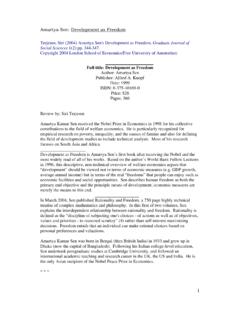Transcription of World Population Ageing 2019 - United Nations
1 WorldPopulationAgeing 2019 ST/ Department of Economic and Social Affairs Population Division World Population Ageing 2019 United Nations New York, 2020 The Department of Economic and Social Affairs of the United Nations Secretariat is a vital interface between global policies in the economic, social and environmental spheres and national action. The Department works in three main interlinked areas: (i) it compiles, generates and analyses a wide range of economic, social and environmental data and information on which States Members of the United Nations draw to review common problems and take stock of policy options; (ii) it facilitates the negotiations of Member States in many intergovernmental bodies on joint courses of action to address ongoing or emerging global challenges.
2 And (iii) it advises interested Governments on the ways and means of translating policy frameworks developed in United Nations conferences and summits into programmes at the country level and, through technical assistance, helps build national capacities. The Population Division of the Department of Economic and Social Affairs provides the international community with timely and accessible Population data and analysis of Population trends and development outcomes for all countries and areas of the World . To this end, the Division undertakes regular studies of Population size and characteristics and of all three components of Population change ( fertility , mortality and migration).
3 Founded in 1946, the Population Division provides substantive support on Population and development issues to the United Nations General Assembly, the Economic and Social Council and the Commission on Population and Development. It also leads or participates in various interagency coordination mechanisms of the United Nations system. The work of the Division also contributes to strengthening the capacity of Member States to monitor Population trends and to address current and emerging Population issues. Notes The designations employed in this report and the material presented in it do not imply the expression of any opinions whatsoever on the part of the Secretariat of the United Nations concerning the legal status of any country, territory, city or area or of its authorities, or concerning the delimitation of its frontiers or boundaries.
4 The term country as used in this report also refers, as appropriate, to territories or areas. This report is available in electronic format on the Division s website at For further information about this report, please contact the Population Division, Department of Economic and Social Affairs, United Nations , Two United Nations Plaza, DC2-1950, New York, 10017, USA; phone: +1 212-963-3209; email: Suggested citation: United Nations , Department of Economic and Social Affairs, Population Division (2020). World Population Ageing 2019 (ST/ ). Official symbols of United Nations documents are composed of capital letters combined with numbers, as illustrated in the above citation.
5 Front cover photo credit: Family vacation at Cameron Highlands, Malaysia , 2019 , UN/Nicole Mun Sim Lai Published by the United Nations Sales No.: E. ISBN: 978-92-1-148326-0 eISBN: 978-92-1-004554-4 Copyright 2020 by United Nations , made available under a Creative Commons license (CC BY IGO) World Population Ageing 2019 United Nations Department of Economic and Social Affairs | Population Division iii PREFACE In the area of Population Ageing , the Population Division of the Department of Economic and Social Affairs of the United Nations Secretariat prepares national, regional and global estimates and projections of the older Population , monitors levels and trends in the distribution of Population by age and analyses information on the relationship between Population Ageing and sustainable development.
6 Periodically, the Division also organizes expert group meetings on various aspects of Population Ageing . This report is the seventh in the series entitled World Population Ageing . The first report was released in 2002 in conjunction with the Second World Assembly on Ageing convened in the same year in Vienna, Austria. The present report provides a description of global trends in Population Ageing and includes an in-depth analysis of new measures that offer an alternative perspective on changes in the Population age structure. It also presents measures to track trends in economic dependency as a result of changes in the Population age distribution.
7 This report was prepared by a team led by Karoline Schmid, including Mun Sim Lai, Yumiko Kamiya and two interns, Heta P yli and Zhangjun Zhou. Bela Hovy, Gavin Jones, Jorge Bravo and John Wilmoth provided guidance and useful comments on the draft report. Guangyu Zhang, Papoute B. Ouedraogo and Neena Koshy assisted in the manuscript s review, formatting and preparation for publication. The present report has been issued without formal editing. Responsibility for World Population Ageing 2019 rests with the Population Division. This page is intentionally left blank. World Population Ageing 2019 United Nations Department of Economic and Social Affairs | Population Division v CONTENTS PREFACE.
8 Iii EXPLANATORY NOTES .. vii INTRODUCTION .. 1 A. Global and regional trends in Population Ageing .. 2 B. Measures of Population Ageing .. 2 C. How does Population Ageing affect assets, transfers and work? .. 3 D. Policy implications for achieving the Sustainable Development Goals .. 4 I. GLOBAL AND REGIONAL TRENDS IN Population Ageing .. 5 II. MEASURES OF Population Ageing .. 13 A. Population Ageing seen from a conventional perspective: the old-age dependency ratio .. 13 B. Measuring Population Ageing considering remaining years to live: The prospective old-age dependency ratio .. 15 C. Comparing the evolution of the OADR and POADR for regions with the highest and lowest OADR 18 D.
9 Measuring Population Ageing from an economic perspective: The economic old-age dependency ratio . 19 E. Comparing the three measures: The OADR, POADR and economic ratios .. 22 III. HOW DOES Population Ageing AFFECT ASSETS, TRANSFERS AND WORK? .. 25 A. How older persons fund their consumption: Transfers, assets, and work .. 27 B. Financing consumption at older ages in coming decades: Projecting transfers, assets and work .. 32 IV. POLICY IMPLICATIONS FOR ACHIEVING THE SUSTAINABLE DEVELOPMENT GOALS .. 35 REFERENCES .. 37 ANNEX I. SOURCES, METHODS AND CLASSIFICATIONS .. 39 ANNEX II. GLOSSARY OF TERMS .. 40 ANNEX III. SUMMARY DATA TABLES .. 42 TABLES Table Number of persons aged 65 years or over, by region, 2019 and 2050.
10 5 Table Number of persons aged 80 years or over, by region, 2019 and 2050 .. 6 Table Life expectancy at birth and age 65, by sex and region, 2015-2020 .. 11 Table Comparison of old-age dependency ratios based on different definitions and methods, by region, .. 23 FIGURES Figure Share of total Population aged 65 years or over, by region, 1990-2050 .. 7 World Population Ageing 2019 vi United Nations Department of Economic and Social Affairs | Population Division Figure Global distribution of Population aged 65 years or over by region, 2019 and 2050 (percentage) .. 8 Figure Global distribution of Population by broad age group, 1990-2050 .. 9 Figure Countries or areas with the largest projected increase in the share of persons.














